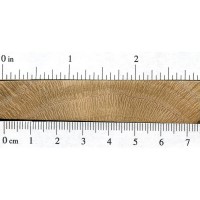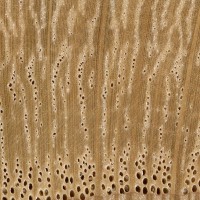 |
Common Name(s): Bur Oak, Burr Oak, Mossycup Oak
Scientific Name: Quercus macrocarpa Distribution: Eastern and Midwestern United States and south-central Canada Tree Size: 80-100 ft (24-30 m) tall, 3-5 ft (1-1.5 m) trunk diameter Average Dried Weight: 45 lbs/ft3 (725 kg/m3) Specific Gravity (Basic, 12% MC): .57, .72 Janka Hardness: 1,360 lbf (6,030 N) Modulus of Rupture: 10,920 lbf/in2 (75.3 MPa) Elastic Modulus: 1,040,000 lbf/in2 (7.17 GPa) Crushing Strength: 5,890 lbf/in2 (40.6 MPa) Shrinkage:Radial: 4.4%, Tangential: 8.8%, Volumetric: 12.7%, T/R Ratio: 2.0 |
Color/Appearance: Has a light to medium brown color, though there can be a fair amount of variation in color. Conversely, Red Oak tends to be slightly redder, but is by no means a reliable method of determining the type of Oak.
Grain/Texture: Has medium-to-large pores and a fairly coarse grain.
Endgrain: Ring-porous; 2-4 rows of large, exclusively solitary earlywood pores, numerous small to very small latewood pores in radial arrangement; tyloses abundant; growth rings distinct; rays large and visible without lens; apotracheal parenchyma diffuse-in-aggregates (short lines between rays).
Rot Resistance: Bur Oak has been rated as having very good resistance to decay.
Workability: Easy to glue, and takes stain and finishes very well.
Odor: Has a tell-tale smell that is common to most oaks. Most find it appealing.
Allergies/Toxicity: Although severe reactions are quite uncommon, oak has been reported as a sensitizer. Usually most common reactions simply include eye and skin irritation, as well as asthma-like symptoms. See the articles Wood Allergies and Toxicity and Wood Dust Safety for more information.
Pricing/Availability: Slightly more expensive than Red Oak, White Oak is in good/sustainable supply and is moderately priced. Thicker 8/4 planks, or quartersawn boards are slightly more expensive per board foot.
Sustainability: This wood species is not listed in the CITES Appendices, and is reported by the IUCN as being a species of least concern.
Common Uses: Cabinetry, furniture, interior trim, flooring, boatbuilding, barrels, and veneer.
Comments: Bur Oak falls into the white oak group, and shares many of the same traits as White Oak (Quercus alba). White Oak, along with its brother Red Oak, are commonly used domestic lumber species. Hard, durable, and moderately priced, White Oak presents an exceptional value to woodworkers—which explains why it is so widely used in cabinet and furniture making.
- Black Oak (Quercus velutina)
- Bog Oak
- Brown Oak
- California Black Oak (Quercus kelloggii)
- Cherrybark Oak (Quercus pagoda)
- Chestnut Oak (Quercus prinus)
- English Oak (Quercus robur)
- Holm Oak (Quercus ilex)
- Japanese Oak (Quercus mongolica)
- Laurel Oak (Quercus laurifolia)
- Live Oak (Quercus virginiana)
- Oregon White Oak (Quercus garryana)
- Overcup Oak (Quercus lyrata)
- Pin Oak (Quercus palustris)
- Post Oak (Quercus stellata)
- Red Oak (Quercus rubra)
- Scarlet Oak (Quercus coccinea)
- Sessile Oak (Quercus petraea)
- Shumard Oak (Quercus shumardii)
- Southern Red Oak (Quercus falcata)
- Swamp Chestnut Oak (Quercus michauxii)
- Swamp White Oak (Quercus bicolor)
- Turkey Oak (Quercus cerris)
- Water Oak (Quercus nigra)
- White Oak (Quercus alba)
- Willow Oak (Quercus phellos)
 |
 |
 |
 |





I live in Calgary Alberta Canada. In 2011, I purchased a bur oak transplant tree on-sale at %50 off at the end of the season. They even gave me an extra tree for free. I thought to my self: what type of oak tree can grow in our climate? 10 years later, I am not disappointed. It is now 20 feet tall from the 5 feet that I purchased-it at. The second tree I planted in British Colombia that has warmer and moister climate. It is doing well too but not as tall. Wow, not only is this species beneficial… Read more »
Is this Bur Oak?
yes, it is!
I live in Sundance, Wyoming. Back in 2013 we had an early snowfall that broke some oaks on my father’s place. I took some of the cut sections and split them in half and turned some natural edged bowls (don’t have to dry them that way) cut, turned, sanded and clearcoated all in one day. Was curious of the type of oak we have, mostly locally called scrub oak, I think based on the info on this site they are probably Bur oak?
Thanks ~Mike
Those are some nice looking natural edged bowls. To tell the individual oaks apart to the species level, I believe you’d probably have to get a look at the leaves, flowers, etc. of a living tree: that’s the best way I know of to get a positive ID.